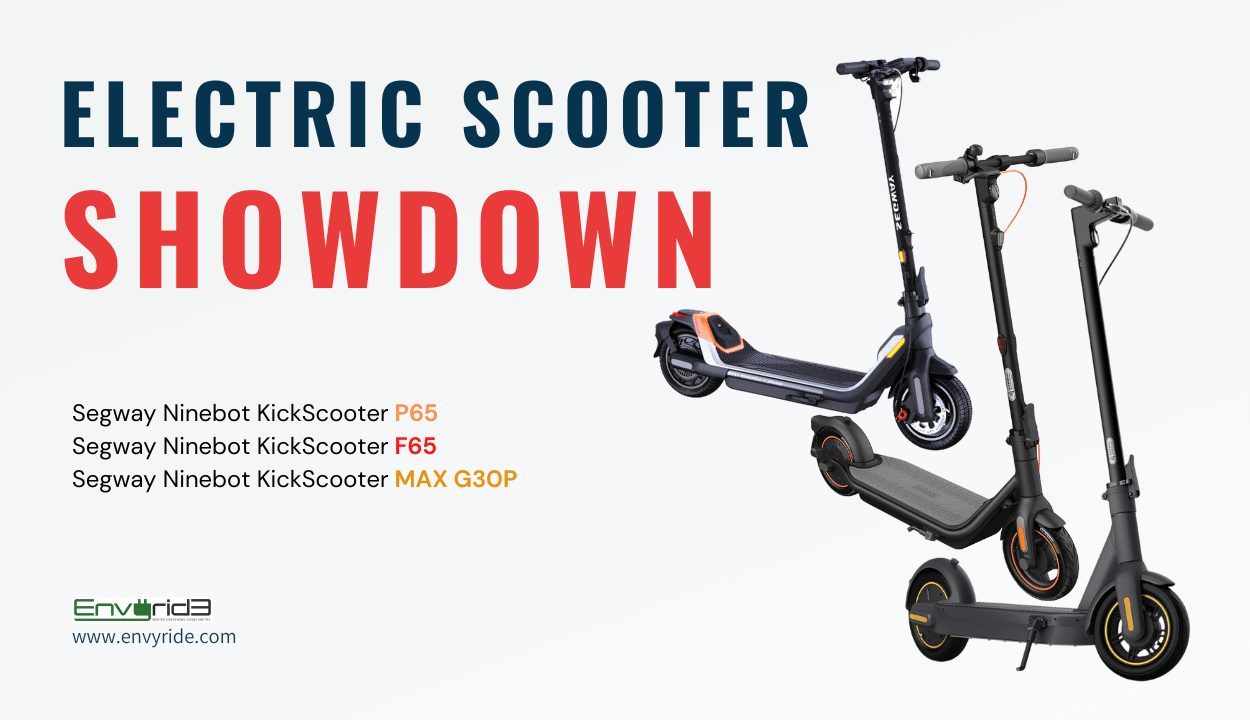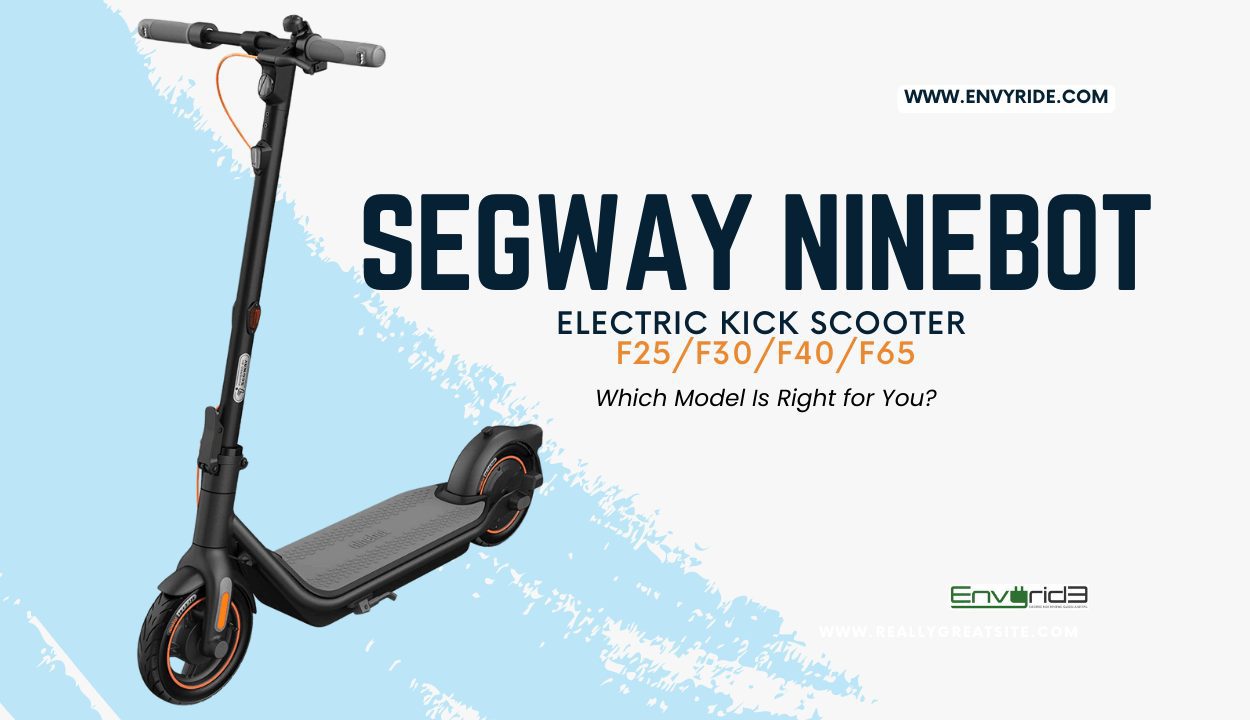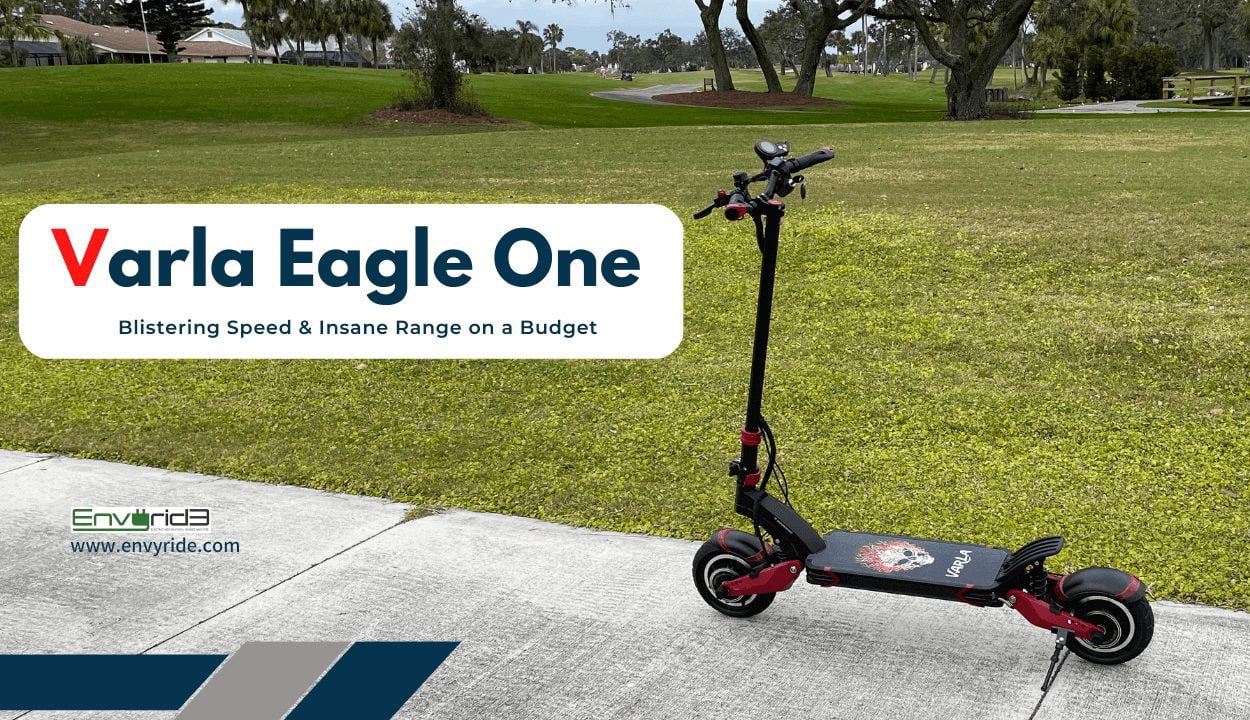
TABLE OF CONTENTS
Before writing this article, I never thought twice about all of the different types of scooter brakes and therefore the advantages and disadvantages of each type.
This article explains the different types of electric scooter brakes and we answer some common questions related to the braking system of an electric scooter.
Similar to a car, electric scooters can have disc brakes or drum brakes. On the slower and cheaper models, you will find foot brakes are also utilized.
Hydraulic Brakes Vs. Mechanical Brakes
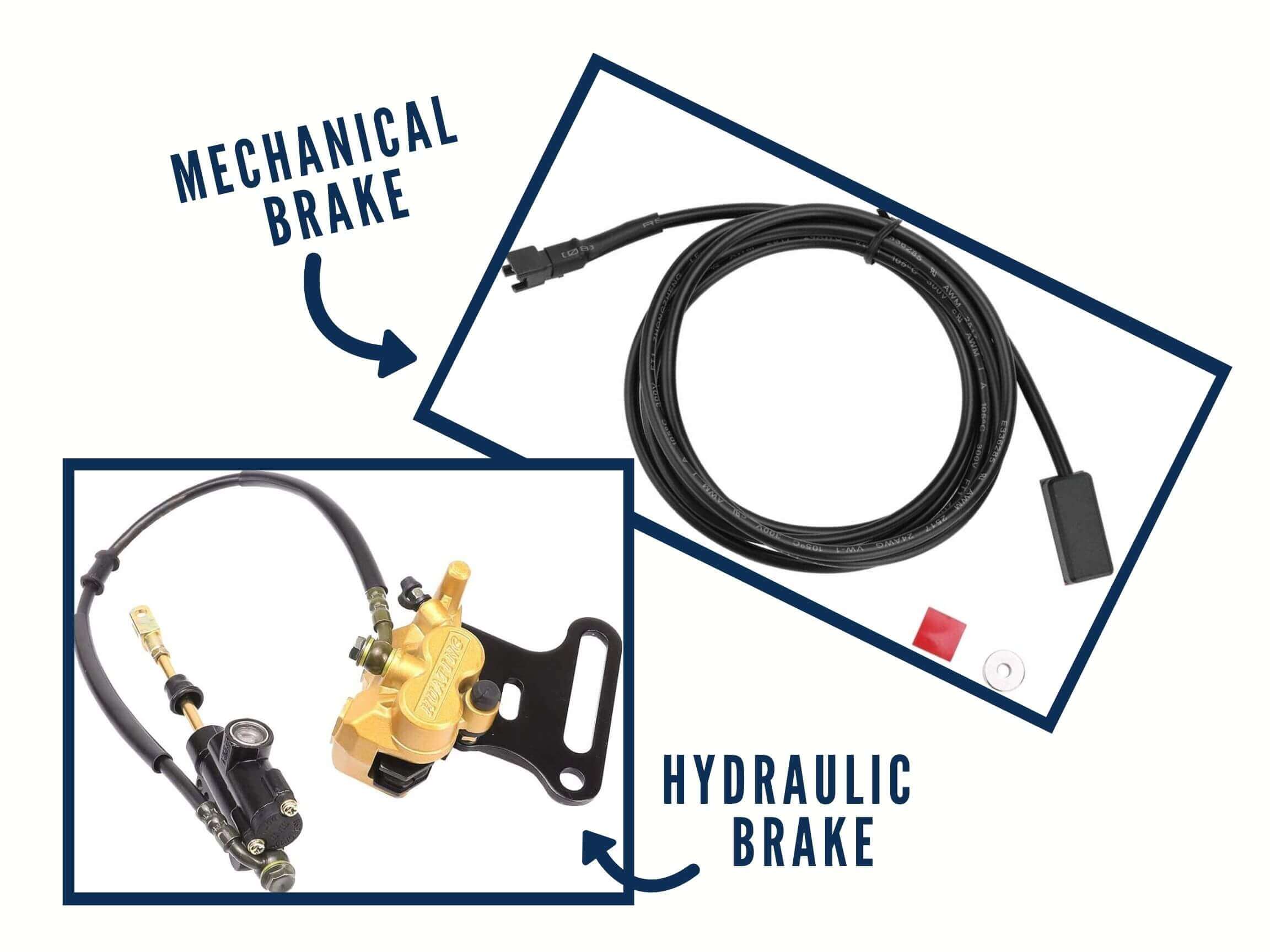
Both disc and drum brakes are either hydraulic or mechanical. With hydraulic disc brakes, braking starts with a mechanical force – you pull the brake lever.
A piston then squeezes or compresses hydraulic fluid into a cylinder which creates pressure (which is much greater than the pressure of you pulling the brake lever) into the brake lines which connect to the brake assembly by hoses.
Inside the brake assemblies, the hydraulic pressure is converted back to mechanical force and the disc or drum’s friction material is pushed against the disc or drum which then stops the scooter.
With mechanical brakes, there is a cable that runs from the lever down to the wheel. When you squeeze the brake lever the length of the cable shortens which squeezes the caliper (in disc brakes). Or, activates a piston that pushes the brake shoes (in a drum) outward against the braking surface which slows the scooter to a stop.
Disc Brakes

With disc brakes, there is a rotor that looks like a disc that’s attached to the wheel assembly and spins while the wheel spins. There are calipers that have sacrificial brake pads (which can be replaced as they wear out) which squeeze against the rotor when pressure is applied to the brake. This causes the scooter to slow to a stop.
Drum Brakes

Drum brake systems are typically enclosed in the hub of the scooter wheel. The drum is attached to the wheel and spins with the wheel. When the brake lever is pulled, sacrificial brake shoes are pushed outward against the drum which causes the scooter to slow down.
One of the major benefits of having drum brakes on a scooter is that the entire braking system is enclosed. This is better if you are riding in wet conditions as it keeps the water out of the braking system. However, to be honest, I much prefer disc brakes to drum brakes. For instance, the GoTrax G4 is an incredible scooter all the way around…especially since it uses disc brakes.
Disc Brakes vs. Drum Brakes
Disc brakes are more effective than drum brakes (located in the hub). Therefore, are most commonly used in electric scooters. You’ll also find that most electric scooters utilize mechanical disc brakes instead of hydraulic disc brakes.
However, hydraulic brakes are generally more effective because more force can be applied to the disc which allows you to stop in a shorter distance. One of the advantages of drum brakes in electric scooters are that because the entire braking system is enclosed they are slightly better for braking in wet conditions.
However, drum braking systems are more difficult to service or adjust, have moving parts and don’t provide as much braking power as disc brakes in electric scooters.
Foot Brake on an Electric Scooter.

Many electric scooters feature a foot brake on the back wheel. This braking system consists of a fender that covers the back tire. In order to apply braking pressure to the back tire, you need to take your foot off the deck and push your heel down on the back fender causing friction on the tire which slows the scooter down.
Foot brakes don’t provide nearly as much braking power as either disc or drum brakes. Additionally, because of the friction that is caused from the back fender touching the tire, the tread on the tire will wear out much faster.
Another disadvantage of the foot brake is that it requires you to take your back foot off the deck of the scooter which can cause you to lose stability. Typically, you won’t find foot brakes on fast electric scooters.
Regenerative Braking System on an Electric Scooter
If you look at buying some of the fastest electric electric scooters you will find that many boast a regenerative brake.
Here is how regenerative brakes work:
When you pull the brake lever of the scooter the brake pads tighten against the rotor (in disc brakes for instance) which cause friction. Regenerative braking systems on scooters capture a small fraction of the kinetic energy generated when you brake and turns it back into usable electric energy.
By recapturing this energy it can be stored in the battery and sent back to the motor when you begin to press the accelerator again. While many manufacturers tout the regenerative braking advantages of their electric scooter model, in practice there is very little effect on overall range.
Electric Scooter Braking Technique – A Pro Move
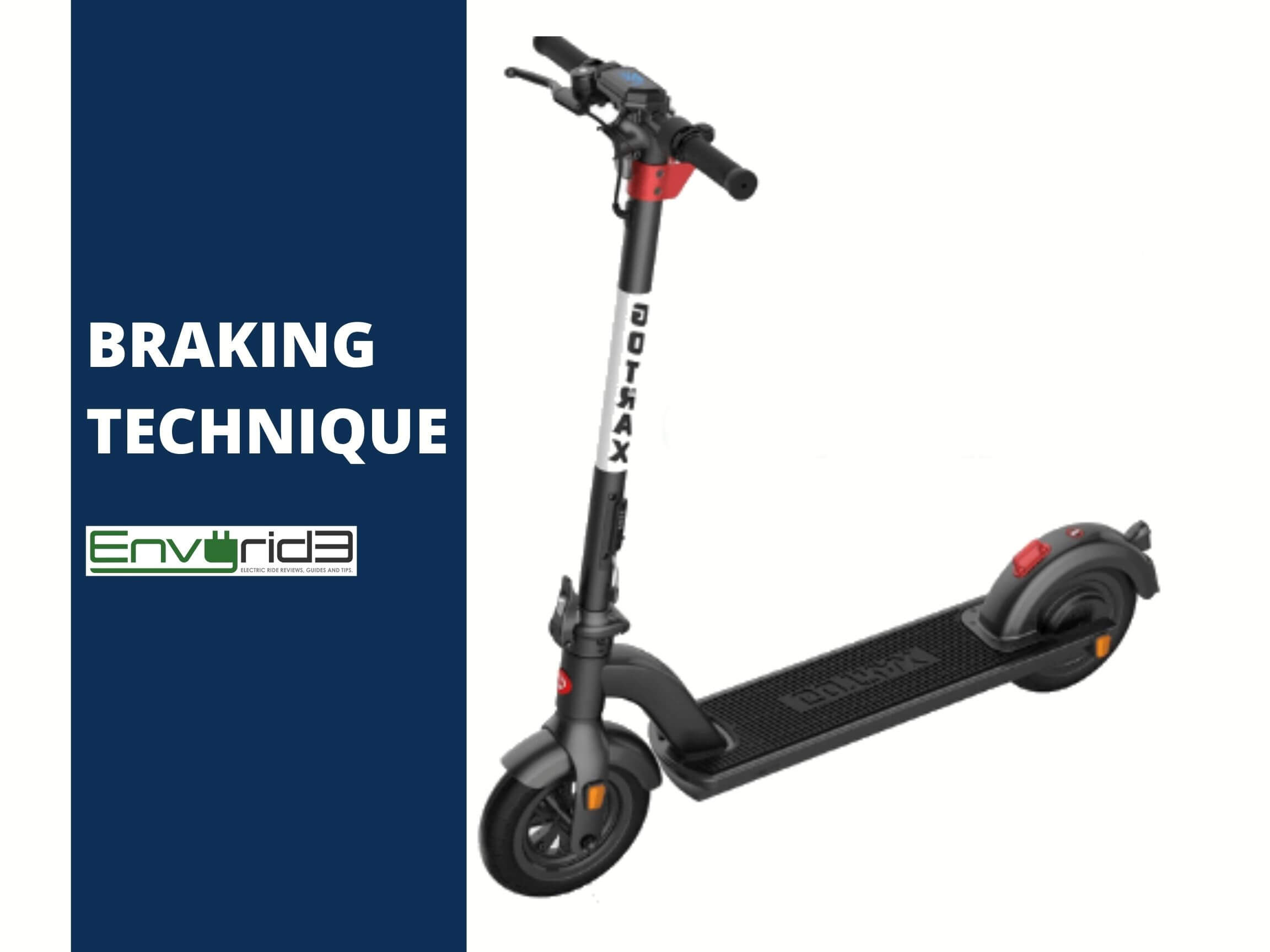
If you’ve been riding for a while you know the key to stopping quickly and quickly on an electric scooter is to lean back – putting your weight towards the back wheel while engaging the hand brake.
The reason for doing this is because, in general, more than 70% of a scooter’s braking power is generated by the brake on the front wheel. If you were to engage the brake without leaning back you run the risk of your body lunging forward, losing control and going over the handlebars. Obviously, this is not what you want to happen!
How do you fix squeaky electric scooter brakes?
If you have an electric scooter, such as the GoTrax G4, you may experience squeaky brakes from time to time. For instance, you may notice the brakes begins to squeak when you hit the engage the brake. Not only is this annoying, but it can also lead to a safety issue.
If the scooter does not come to a smooth stop, then you may end up falling from the scooter, leading to an injury. Therefore, why do electric scooter brakes squeak in the first place? How do you fix squeaky electric scooter brakes? Take a look at some useful information below.
Why Do Electric Scooter Brakes Start To Squeak?
If you are experiencing squeaky brakes on your electric scooter, it is important to understand why this takes place. Some of the most common reasons why you are electric scooter brakes may start to squeak include:
-
Your new brake pads might not be completely embedded in the scooter
-
If the brakes have not been designed properly, this can lead to vibrations, which create a squeaking noise when you try to use the brakes
-
There might be a source of contamination within the brakes themselves that leads to a noise when you hit the anchors
-
There might be an alignment issue between the brakes and the surfaces themselves
After a few dozen miles, if you start to notice squeaky electric scooter brakes, contamination is the most likely cause. Some of the most common locations of this contamination include the brake pads, the rotors, or the wheel rims.
If you are trying to get rid of contamination in your electric scooter brakes, there are a few steps that you should follow.
How To Fix Squeaky Brakes on an Electric Scooter
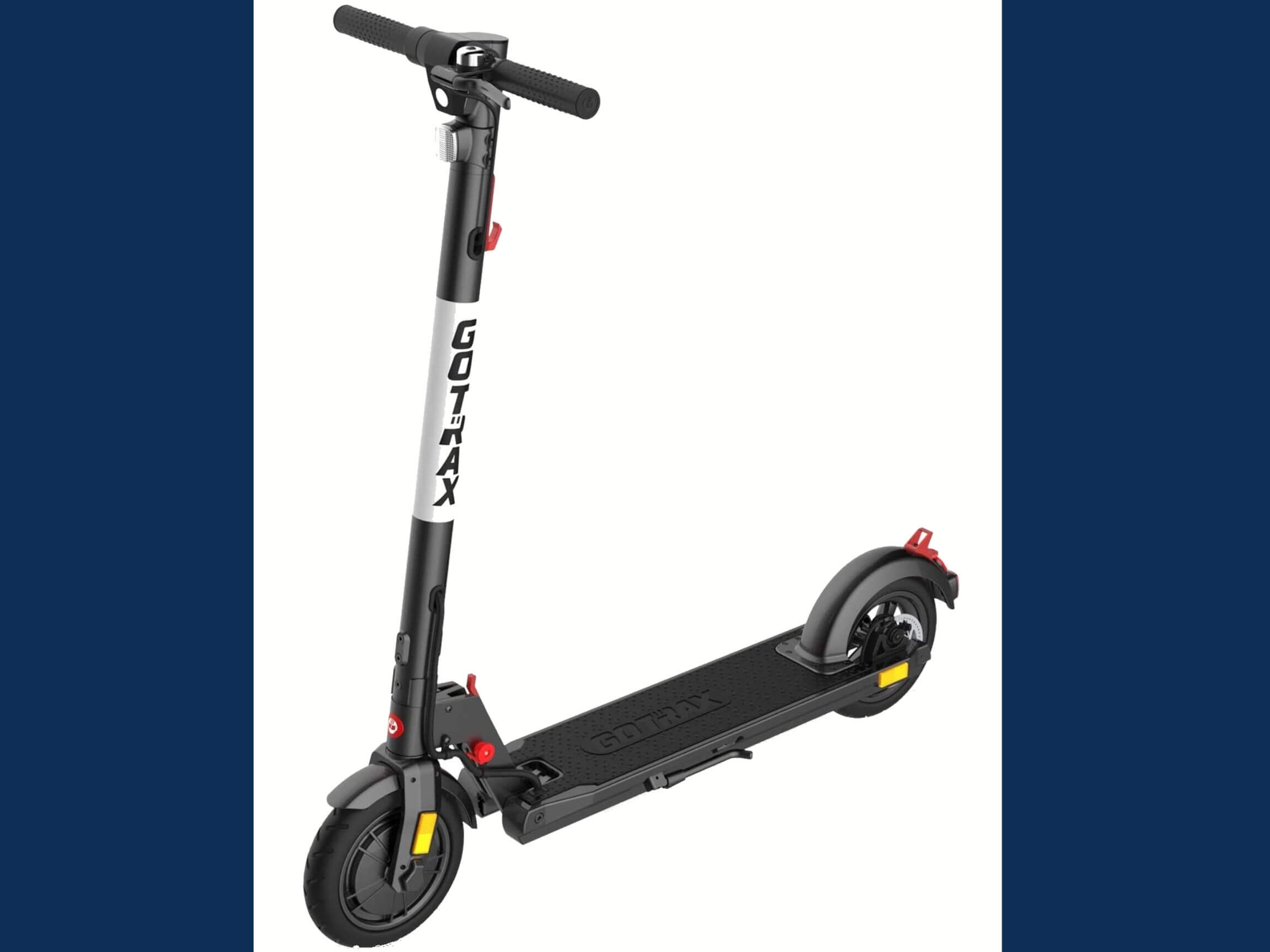
If you are ready to fix squeaky brakes on your electric scooter, you need to get rid of any contamination that is present. Therefore, the first thing you should do is take a look at the rims.
Make sure there is no dirt that has been built up along them. If the rims have become dirty, use a degreaser and scrub them thoroughly. Then, take a look at the brake blocks as well. Make sure that they do not have any dirt regret on them either.
Next, you need to make sure that your brake pads are not worn out. If your brake pads are wearing unevenly, this could also lead to squeaky brakes. It could also be a sign that your brakes have not been set up properly.
On disc brakes, you should ensure there is no dirt or dust build up on the disc itself. If you notice this issue, you will need to use a dry, dust free cloth (I suggest a microfiber cloth) to wipe way any debris from the disc.
If you have drum brakes that are squeaking, you can disassemble the hub that contains the drum and clean the drum surface and brake pads using a dust free cloth.
Fixing drum brakes can be a bit more tricky than fixing disc brakes and if you are not comfortable with disassembling the braking system to clean these components it might be wise to reach out to a professional to help you fix your brakes.
Once you have cleaned your brakes thoroughly, make sure that all the bolts that secure the calipers to your frame have been tightened. If the bolts are loose, this can also lead to squeaky brakes.
Finally, make sure that you lubricate the brake line and any parts that can become dirty. Although, I don’t like to lubricate the disc or drum because it creates a slippery surface which can cause your brakes not to be effective in stopping the scooter. So, make sure you’re not lubricating the disc or the drum.
What if They Are Still Squeaking?
If you have gone through all of this work and your electric scooter brakes are still squeaking, then they might not have been set out properly. First, apply the brake. Then, take a look at the rim and the brake pad surfaces. If you notice they are not connecting appropriately, then you may need to loosen the mounting bolts and retighten the brake pads so they apply pressure evenly to the disc (or drum).
If you find that you are still unable to address the issue, it might be time to reach out to a professional for assistance. The brakes might have to be taken apart and put back together once again.
How To Fix Electric Scooter Brakes
If you want to ensure a smooth, safe ride, then you need to take care of your scooter. This includes the brakes. From time to time, you may notice that your electric scooter brakes are starting to squeak.
Usually, there is dirt, grit, or oil building up between the brakes and the surfaces. You can address this issue by cleaning the brakes thoroughly. Make sure that you lubricate the braking components on a regular basis as well. If the brake pads are worn, make sure you replace them.
I hope you found this article helpful and informative. Please leave a comment below if you’d like to join in the conversation!







